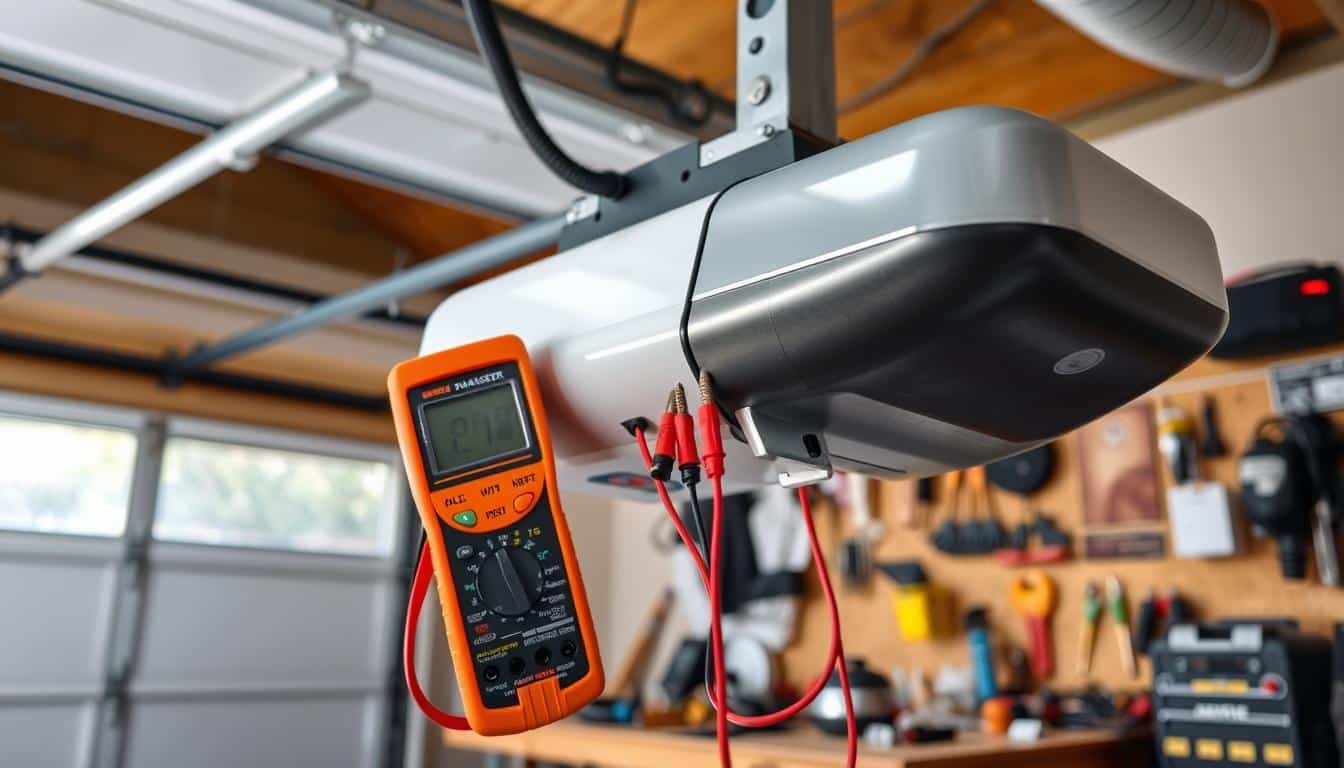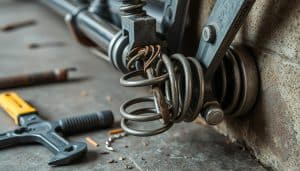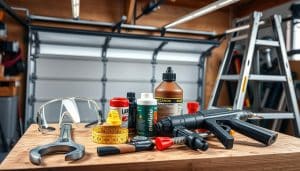Ever found yourself stuck because your garage door won’t open? How Do I Troubleshoot a Garage Door Opener? It’s a common problem. Learning to fix a garage door opener can save you time and money. We’ll cover common issues and how to solve them.
With this knowledge, you can handle most problems yourself. Sometimes, you might need a professional’s help. But knowing when to ask for help is key.
Understanding your garage door opener is the first step. We’ll look at different types and their parts. This will help you tackle issues like a faulty remote or a blocked door path.
Let’s get ready to tackle garage door opener problems together!
Key Takeaways
- Understanding how to troubleshoot a garage door opener is key for quick fixes.
- Many issues come from simple mistakes or mechanical problems.
- Regular upkeep can stop many problems and make your opener last longer.
- Don’t overthink simple issues like a blocked door path.
- Most problems can be fixed with basic checks and resets.
- If unsure, check your model manual for troubleshooting tips.
Understanding Garage Door Openers
Garage door openers come in different types and have various components. Knowing how they work helps us fix problems better.
Types of Garage Door Openers
There are mainly three types: chain drive, belt drive, and screw drive. Chain drives are durable and last 15 to 30 years. Belt drives are quieter, great for homes with living spaces above the garage.
Screw drives need less maintenance and last about 5 to 7 years.
Common Components of Garage Door Openers
Garage door openers have key parts for working right. The motor is the main driver. Other important parts are the rail, gears, and safety sensors.
Safety sensors have lights to show they’re working right. Keeping tracks and rollers in good shape helps keep noise down.
How Openers Work
It’s important to know how openers work. A remote sends a signal to the opener. This makes the motor move the door up or down.
But, if the safety sensor is off or a gear breaks, the opener stops. Regular checks help avoid problems.
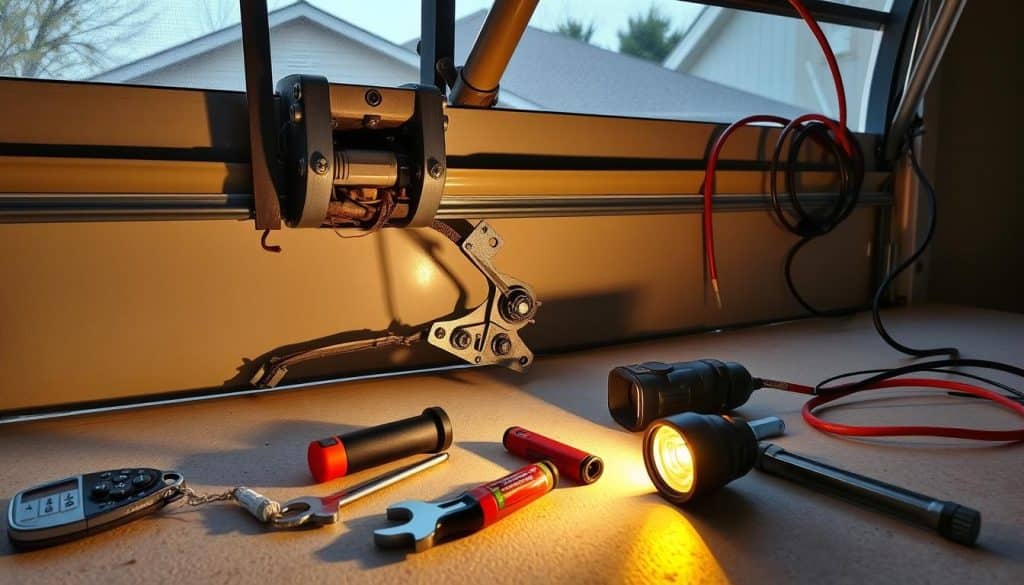
Common Issues with Garage Door Openers
We often face various garage door opener problems that can be frustrating. Knowing the most common issues helps us troubleshoot effectively. Issues like a door not opening or closing, remote control problems, and unusual noises are common. Spotting these problems early can save us time and money.
Door Does Not Open or Close
Many homeowners face the issue of a door not opening or closing right. This can be due to misaligned sensors, worn-out springs, or wrong settings. It’s important to check for power issues, which cause about 25% of problems. Regular maintenance and troubleshooting tips can prevent these issues and ensure smooth operation.
Remote Control Problems
Remote control failure is a common problem, affecting about 25% of malfunctions. Dead batteries, signal interference, or physical damage can cause these issues. Most remotes need battery replacements every two years. A quick test with a wall-mounted system can help figure out if the remote or opener is the problem. Following effective troubleshooting tips can help solve these common issues.
Unusual Noises During Operation
Unusual noises during operation can signal mechanical problems. These noise issues affect about 30% of homeowners and can come from loose hardware or lack of lubrication. It’s key to identify and fix these issues to keep the garage door opener working well. Regular maintenance checks can greatly reduce these annoying sounds and improve the garage door’s performance.
Initial Troubleshooting Steps
When we face problems with our garage door opener, starting with some basic steps can fix it. Knowing where to begin helps us avoid common issues. This way, we can use our garage door again without needing a professional.
Check the Power Supply
First, we should check the power supply connections of the garage door opener. Make sure it’s plugged in right and check the outlet for a blown fuse. Many problems start with a simple power issue, as 70% of issues are due to power failures.
If everything looks good, using a surge protector can protect the circuit board from electrical surges.
Inspect the Remote Battery
Next, we should check the remote battery. Dead batteries cause nearly 30% of remote control problems. Replacing the battery can quickly fix the issue, saving us time and money.
Ensure the Door is Not Obstructed
Lastly, we must make sure the door path is clear. Misaligned or blocked safety sensors cause 20% of failures. Look for debris or toys that might be blocking the way. By following these steps, we can avoid bigger problems and make repairs easier.
Inspecting Safety Features
It’s vital to check our garage door openers’ safety features to avoid accidents and ensure they work well. We should first test the garage door safety sensors. These sensors are meant to spot objects in the door’s way. If they work right, the door should go back up as soon as it hits something.
Test the Safety Sensors
We should test the safety sensors every month. Place an object in the door’s path and see if it goes back up. If it does, it means the sensors are working and we’re safe.
Check for Proper Alignment
Then, we need to make sure the safety sensors are lined up right. They should be about six inches off the ground on both sides of the door. If they’re not, the door might not work right. We need to adjust them so they face each other.
Resetting Safety Features
If the sensors are off or not working, we might need to reset them. This means turning off power to the opener and following the maker’s guide for resetting. Doing this often keeps our garage door safe and working well.
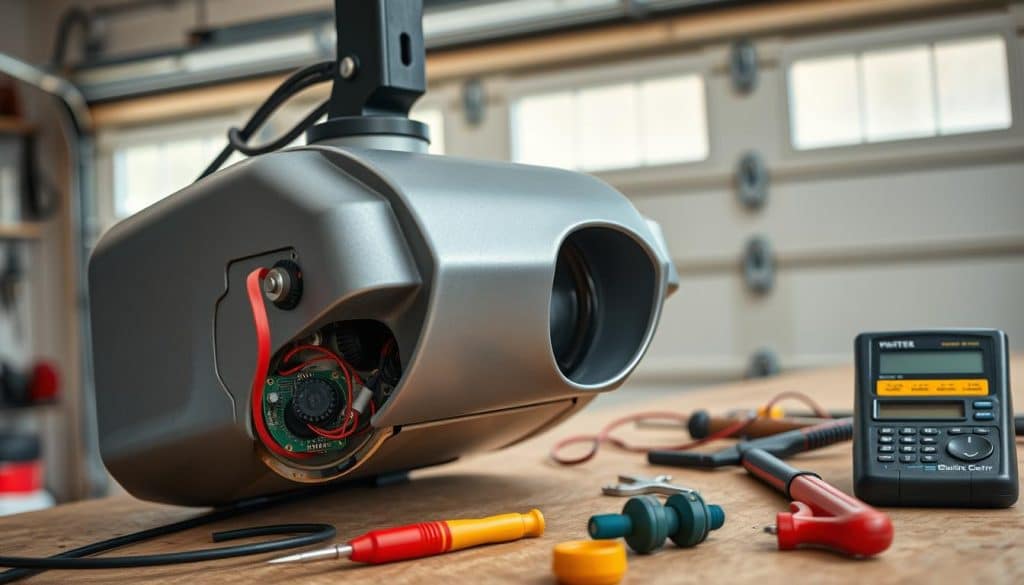
Assessing the Remote Control
The remote control is essential for our garage door systems to work. If our garage doors act up, checking the remote is a smart first step. Often, issues like doors not opening can be fixed by reprogramming the remote or replacing the battery.
Reprogramming the Remote
Reprogramming the remote might be needed if it doesn’t talk to the garage door opener. Each system has its own way to do this. We start by finding the learn button on the opener, pressing it, and then the remote button to link them up. This fixes the connection and gets things working again.
Replacing the Remote Battery
About half of remote problems are due to dead batteries. If the range gets shorter or it acts up, it’s time for a new battery. Most remotes use CR2032 batteries, making it easy to fix. Just open the remote, take out the old battery, and put in a new one, making sure it’s the right way around.
Troubleshooting Wireless Issues
If reprogramming and battery changes don’t work, we need to dig deeper. Issues like new gadgets causing interference or being too far from the door can be the problem. If the remote only works close to the door, check for interference. Also, make sure the battery contacts are clean, as dirty ones can cause 15% of remote failures.
Evaluating the Garage Door Mechanism
It’s important to check our garage door system often. We should look at parts like tracks, rollers, springs, and cables. This helps avoid small problems from getting bigger.
Inspecting Tracks and Rollers
Checking tracks regularly is key. About 25% of garage door problems come from misalignments or blockages. Make sure tracks are clean and rollers work right. Worn-out rollers can cause friction or get stuck.
Testing Springs and Cables
It’s also vital to test springs and cables for wear. Springs handle the door’s weight, and a failure is dangerous. Look for wear signs to avoid safety risks. Cables can break, happening about 10% of the time, so check them too.
Lubricating Moving Parts
Don’t forget to lubricate garage door parts. This can make the system last up to 50% longer. Lubrication reduces friction, prevents rust, and keeps things moving smoothly. Use a silicone-based lubricant for the best results.
When to Call a Professional
Knowing when to call a professional for garage door issues is key. It keeps your garage door safe and working right. Signs like constant problems or visible damage mean you need help.
Ignoring these signs can cause bigger problems later. So, getting help quickly is very important.
Signs You Need Professional Help
There are many signs you might need a pro. Unusual noises like grinding or screeching mean something’s wrong. Visible damage, like burnt wiring or broken springs, also needs quick action.
If trying to fix it yourself doesn’t work, it’s time to call a pro. This can save you time and money.
Why Choose Emerald Garage Door Services
Emerald Garage Door Services is a trusted choice for garage door repairs. We are fully licensed and insured, ensuring your safety. Our team is well-trained to fix all sorts of garage door problems.
What to Expect from Our Technicians
Our technicians will give you a detailed and professional service. They will carefully check your garage door system. This ensures all problems are fixed.
We aim to make you happy with our service. Our goal is to fix your garage door safely and efficiently.
Maintenance Tips for Garage Door Openers
Keeping your garage door opener in good shape can make it last longer and keep you safe. Regular care helps avoid big problems and saves money on repairs. A simple maintenance checklist for garage doors includes regular checks and cleaning.
Regular Maintenance Checklist
To keep your garage door opener running smoothly, follow a maintenance plan. Lubricate moving parts every six months. Also, clean the door tracks for dirt and tighten loose bolts.
Look for any damage, as small issues can quickly become big problems. Testing safety features regularly is also key. About 20% of accidents are caused by faulty sensors.
The Importance of Cleanliness
Cleaning around your garage door opener is just as important as the mechanical work. Dirt and debris can make the door look bad and work poorly. Clean sensors are essential to avoid accidents.
Wipe down the opener and its parts often. Keeping them clean is vital for your garage door to function correctly.
Seasonal Maintenance Guidelines
Check your garage door opener at least twice a year, following seasonal guidelines. Look for wear from the weather and check if lubricants are working. Adjustments might be needed for temperature changes.
Seasonal checks help catch small problems before they get big. Up to 30% of garage door opener issues come from poor maintenance.
Contacting Emerald Garage Door Services
Having trouble with your garage door opener? It’s important to know how to reach Emerald Garage Door Services quickly. We’re based in Orlando and offer top-notch garage door service. Call us at (407) 788-1229 for help anytime. Our team is ready to assist you 24/7.
We’re all about quality service. Our parts last longer, improving repair life by 20-40%. Our customers are happy, with 90% saying we’re quick and effective. We back our parts and labor, so you can trust us with your garage door.
Ready for a garage door appointment? Just call us or visit our website during business hours. We’ll find a time that works for you. Our team is here to help with maintenance or repairs, keeping your garage door in top shape.


